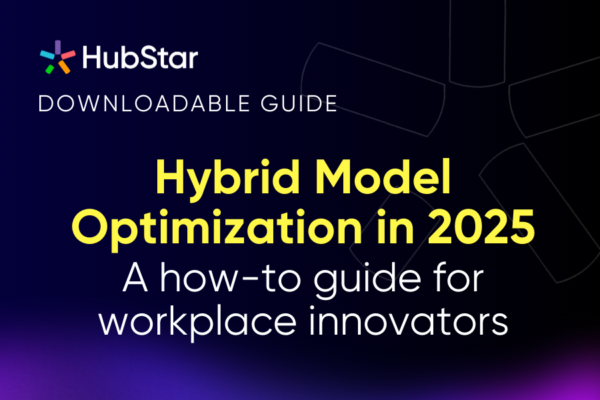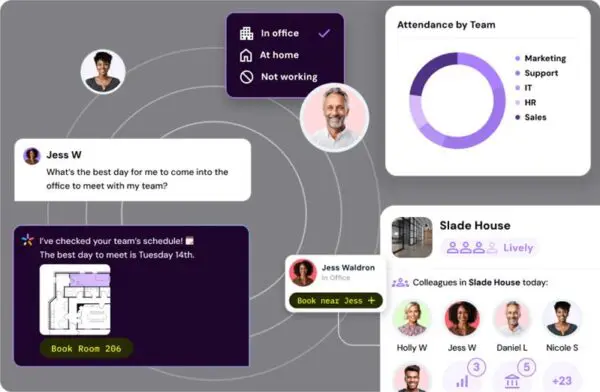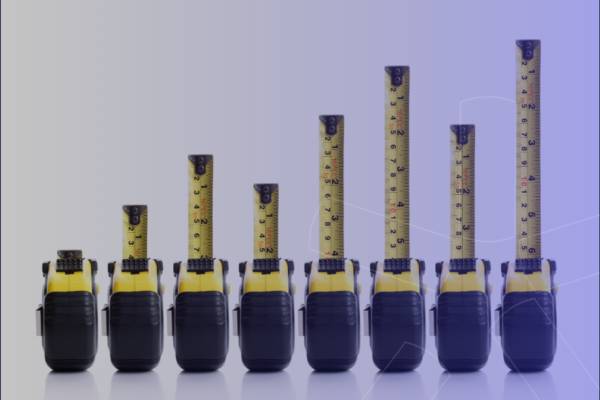4 Facilities Management Trends for 2025

The facilities management market is predicted to surge to a valuation of $2873 billion USD by 2028.
Sure, this might make the future of facilities management look promising and bright, but the reality is that corporate facility management teams have been in a constant state of flux, along with the role of the workplaces they manage. That’s not changing anytime soon.
What’s in the future for corporate facilities management teams next year? Here are fiour trends that will help facilities management teams navigate uncertainty, make the right decisions and get ROI back from physical spaces.
1. More modular spaces mean more maintenance challenges.
Fixed space is out (kinda), and flex space is in.
43% of businesses are planning on investing in flexible, modular office spaces in 2025. Think movable walls, modular furniture, adaptable zones and lots of office pods. Companies specializing in modular office solutions have seen their revenue growth skyrocket up to 300% in the last four years.
And while this is fantastic news for everyone tired of cubicle farms and battling to the death for meeting rooms, it also brings a new set of challenges for FM teams. That’s because lots of moving parts can turn cleaning and maintenance into a game of musical chairs or whack-a-mole – especially with higher utilization levels that naturally follow the creation of better workspaces.
A study from early 2024 revealed that 40% of FM employees in the U.S. were involved in clearing and reconfiguring buildings – a 12% jump from the year before.
However, more modular spaces doesn’t necessarily mean more maintenance work. Workplace data can help FM teams do everything from creating targeted clearing schedules to allocating resources efficiently.
Hybrid Model Optimization in 2025: A How-To Guide for Workplace Innovators
Trying to get all your ducks in a row for your workplace strategy in 2025? We've got you covered with this deep dive into creating a workplace strategy built for the dynamic world of work we currently find ourselves in.

2. FM teams will make pedal hit metal on workplace sustainability.
28% of global carbon emissions come from building emissions. That puts facilities management teams on the frontline of operating and maintaining workplaces in the most sustainable ways. Things are ramping up with the urgency of achieving Net Zero building standards, plus other regulations like the EU’sCorporate Sustinability Reporting Directive and the global Task Force on Climate-Related Financial Disclosures.
FM teams will focus heavily on retrofitting older buildings to meet global climate commitments. With 85% of existing buildings globally needing retrofits to meet environmental targets, FM teams will be the ones making the magic happen. We can expect to see widespread adoption of energy-efficient HVAC systems, solar panels, and LED upgrades.
But 2025 will be different, because FM teams can’t do it alone. Sustainability needs to be tightly woven into CRE portfolio optimization, workplace strategy, hybrid and HR policies and so much more. That means status quo silos between Real Estate, Workplace, HR and FM teams will need to be torn down. And with some FM teams reporting into HR, it’s already starting to happen.
Over half of U.S. companies have already formed cross-functional ESG teams, signaling the start of a year of cross-functional workplace decision making.
4 Ways to Reduce Office Carbon Footprint by Understanding Workplace Occupancy
Workplaces around the world are under pressure to slash their carbon emissions, and fast. Understanding occupancy data can help - here's how.

3. Data-driven facilities management 2.0
Workplace maintenance needs are steadily becoming more unpredictable – without data, that is. Next year, we’ll see FM teams rely more on occupancy sensors, space utilization data, and digital twin technology to build more certainty into cleaning and maintenance processes.
Real-time insights help FM teams make data-driven decisions on energy use, space optimization, and maintenance. Space utilization data can help agile FM teams prioritize cleaning and maintenance in high-traffic areas, such as increasing the frequency of bathroom cleanings or shifting employees away from crowded zones like the cafeteria.
Predictive maintenance powered by AI will also anticipate issues before they arise, slashing downtime and costs.
However, only 17% of FM professionals are confident their current systems can meet rapidly changing workplace demands. Tech definitely has some catching up to do next year.
5 Space Utilization Metrics for a Better Workplace in 2025
As we head into 2025, workplace leadership is increasingly focused on quantifying the unquantifiable. These metrics will help you quantify the workplace improvements you need to make.

4. Prioritizing employee wellbeing will change FM workflows.
Data shows that a workplace that focuses on wellbeing is a more successful workplace. A Lawrence Berkeley study found that improving ventilation alone can boost employee productivity by 11%.
Expect to see increased investment in air purification systems, noise control measures, and ergonomic upgrades like more standing desks and curved screens.
But similarly to modular workspaces, maintaining these systems means changing the way work gets done. Filter replacements, and integration with smart building systems to ensure optimal performance. Noise control measures need periodic assessments and calibrations to remain effective. Ergonomic upgrades like adjustable furniture and workstations need routine checks to address wear and tear and ensure employee comfort.
But again – workplace occupancy data to the rescue. Working data into the core of FM workflows makes teams more agile, focusing on the wellness spaces and systems that need the most attention.
Make your FM teams more agile in 2025 with HubStar H2O
H2O is the only dynamic workplace platform that combines next-generation scheduling, real-time occupancy data and hybrid data management. Find out how H2O can help your FM teams stay agile and focus their time where it makes the most impact.

Share this post






















